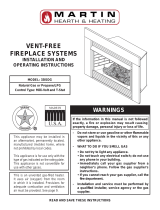
44D0060 3
IMPORTANT SAFETY INFORMATION
10. This unit complies with ANSI Z21.11.2-2001 Unvented
Heaters and also complies with ANSI Z21.60-2000 Deco-
rative Vented Appliances for Solid Fuel Burning Fire-
places. State and local codes may only allow operation
of this appliance in a vented conguration. Check your
state or local codes. For vented operation, see “Vented
Instructions” in this manual.
11. Do not install the heaters in a bathroom or bedroom.
12. Correct installation of the ceramic ber logs, proper
location of the heater, and annual cleaning are necessary
to avoid potential problems with sooting. Sooting,
resulting from improper installation or operation,
can settle on surfaces outside the replace. See log
placement instructions for proper installation.
13. Avoid any drafts that alter burner ame patterns. Do not
allow fans to blow directly into replace. Do not place
a blower inside burn area of rebox. Ceiling fans may
create drafts that alter burner ame patterns. Sooting
and improper burning will occur.
14. Caution: Candles, incense, oil lamps, etc. produce
combustion byproducts including soot. Vent-free
appliances will not lter or clean soot produced by
these types of products. In addition, the smoke and/or
aromatics (scents) may be reburnt in the vent-free
appliance which can produce odors. It is recommended
to minimize the use of candles, incense, etc. while the
vent-free appliance is in operation.
15. This is an unvented gas-red heater. It uses air (oxygen)
from the room in which it is installed. Provisions for
adequate combustion and ventilation air must be pro-
vided. See page 8.
INSTALLER
Please leave these instructions with the owner.
OWNER
Please retain these instructions for future reference
.
IMPORTANT
Read these instructions carefully before installing or trying to operate this vent-free gas heater.
1. Due to high temperatures, the appliance should
be located out of trafc and away from furniture
and draperies.
2. Children and adults should be alerted to the hazard
of high surface temperature and should stay away to
avoid burns or clothing ignition.
3. Young children should be carefully supervised when
they are in the same room with the appliance.
4. Do not place clothing or other ammable material
on or near the appliance.
5. Any safety screen or guard removed for servicing an
appliance, must be replaced prior to operating the
heater.
6. Installation and repair should be done by a qualied
service person.
7. To prevent malfunction and/or sooting, an unvented
gas heater should be cleaned before use and at least
annually by a professional service person. More fre-
quent cleaning may be required due to excessive lint
from carpeting, bedding material, etc. It is imperative
that control compartments, burners and circulating air
passageways be kept clean.
8. CARBON MONOXIDE POISONING: Early signs of
carbon monoxide poisoning are similar to the u with
headaches, dizziness and/or nausea. If you have these
signs, obtain fresh air immediately. Have the heater
serviced as it may not be operating properly.
9. The installation must conform with local codes or, in
the absence of local codes, with the National Fuel Gas
Code, ANSI Z223.l/NFPA54. Continued on page 4
• Any change to this heater or its controls can be dangerous.
• Improper installation or use of the heater can cause serious injury or death from fire,
burns, explosion or carbon monoxide poisoning.
• Do not allow fans to blow directly into the fireplace. Avoid any drafts that alter
burner flame patterns.
• Do not use a blower insert, heat exchanger insert or other accessory, not approved
for use with this heater where applicable.
WARNING






















